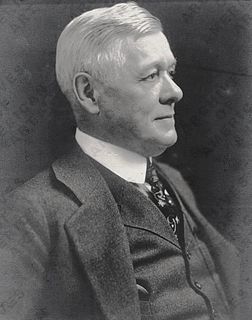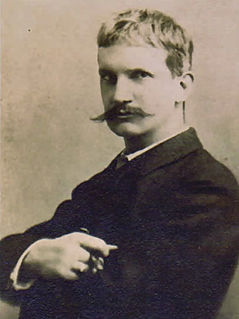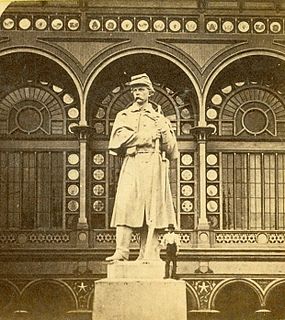
Randolph Rogers was an American Neoclassical sculptor. An expatriate who lived most of his life in Italy, his works ranged from popular subjects to major commissions, including the Columbus Doors at the U.S. Capitol and American Civil War monuments.

Caspar Buberl was an American sculptor. He is best known for his Civil War monuments, for the terra cotta relief panels on the Garfield Memorial in Cleveland, Ohio, and for the 1,200-foot (370 m)-long frieze on the Pension Building in Washington, D.C.

George Keller was an American architect and engineer. He enjoyed a diverse and successful career, and was sought for his designs of bridges, houses, monuments, and various commercial and public buildings. Keller's most famous projects, however, are the Soldiers and Sailors Memorial Arch in Hartford, Connecticut, and the James A. Garfield Memorial in Cleveland, Ohio.

John Massey Rhind was a Scottish-American sculptor. Among Rhind's better known works is the marble statue of Dr. Crawford W. Long located in the National Statuary Hall Collection in Washington D.C. (1926).

Francis Edwin Elwell was an American sculptor, teacher and author.

Cedar Hill Cemetery in Hartford, Connecticut is located at 453 Fairfield Avenue. It was designed by landscape architect Jacob Weidenmann (1829–1893) who also designed Hartford's Bushnell Park. Its first sections were completed in 1866 and the first burial took place on July 17, 1866. Cedar Hill was designed as an American rural cemetery in the tradition of Mount Auburn Cemetery in Cambridge, Massachusetts.

James Goodwin Batterson was an American designer and builder, the owner of New England Granite Works from 1845 and a founder in 1863 of Travelers Insurance Company, both in Hartford, Connecticut. He introduced casualty insurance in the United States, for which he was posthumously inducted into the Insurance Hall of Fame (1965).

Soldiers' Monument is in Bristol, Connecticut, on top of a hill in the city’s West Cemetery. The monument is an obelisk with a brownstone eagle on top. At the base on its eastern side, there is a dedication honoring the men from Bristol who fought and died for their country. To the west of the monument is a marker honoring veterans of other wars.

The Soldiers' National Monument is a Gettysburg Battlefield memorial which is located at the central point of Gettysburg National Cemetery. It honors the battle's soldiers and tells an allegory of "peace and plenty under freedom … following a heroic struggle." In addition to an inscription with the last 4 lines of the Gettysburg Address, the shaft with 4 buttresses has 5 statues:
A large statue representing the concept of Liberty surmounts the pedestal. Eighteen large bronze stars circling the pedestal below this statue represent the eighteen Union states with buried dead. A statue is located at each corner near the base. They represent War, History, Peace, and Plenty. War is represented by a statue of an American soldier who recounts the story of the battle to History. In turn, History records, with stylus and tablet, the achievements of the battle and the names of the honored dead. A statue of an American mechanic and his tools illustrates Peace. Plenty is a female figure with a sheaf of wheat and the fruits of the earth that typify peace and abundance as the soldier's crowning triumph.

Karl Gerhardt was a United States sculptor, best known for his death mask of President Ulysses S. Grant and a portrait bust of Mark Twain.

William Clark Noble was an American sculptor best known for his monuments.

Henry Jackson Ellicott was an American sculptor and architectural sculptor, best known for his work on American Civil War monuments.

Carl H. Conrads was an American sculptor best known for his work on Civil War monuments and his two works in the National Statuary Hall Collection at the U.S. Capitol in Washington, D.C. He was also known as Charles Conrads.

The American Volunteer – also known as The American Soldier – is a colossal granite statue that crowns the U.S. Soldier Monument and forms the centerpiece of Antietam National Cemetery in Sharpsburg, Maryland. The monument is also known as the Private Soldier Monument.

Edward Ludwig Albert Pausch was a Danish-American sculptor noted for his war memorials.

An outdoor granite sculpture of Alexander Hamilton by Carl Conrads is installed in Central Park, Manhattan, New York. Hamilton's son, John C. Hamilton, commissioned Conrads to sculpt this statue, which was dedicated on November 22, 1880, and donated to the city. Conrads used the bust of Hamilton created by the sculptor Giuseppe Ceracchi as a model for Hamilton's head.
James G. C. Hamilton was an American sculptor active in Cleveland, Ohio from about 1887-1898. According to Artists in Ohio, he was said to be a graduate of the Pennsylvania Academy of the Fine Arts, and according to the Building News and Engineering Journal, he served as an assistant to Alexander Milne Calder for sculptures in the Philadelphia City Hall. Hamilton was a Freemason as a member of Franklin Ledge #20.

The Israel Putnam Monument is an equestrian statue located in Brooklyn, Connecticut, United States. The monument, designed by sculptor Karl Gerhardt, was dedicated in 1888 in honor of Israel Putnam, a Connecticut native who served as a general in the Continental Army during the American Revolutionary War. The monument was created as a response to the deteriorated condition of Putnam's grave in Brooklyn's cemetery, and the state government allocated funds for the monument with the provision that it also serve as a tomb for Putnam. Upon its completion, Putnam's remains were reinterred under the monument. The dedication was held on June 14 in a large ceremony with several guests of honor, including the governors of Connecticut and Rhode Island. The monument was criticized by contemporary reviewers, who especially criticized the horse, with one review noting that it appeared to be suffering from bone spavin.

The New York State Monument is a large monument at the Gettysburg National Cemetery in Pennsylvania. The granite and marble monument was dedicated in 1893 honors the soldiers from New York who died at the Battle of Gettysburg during the American Civil War. It was commissioned by the New York Monuments Commission and designed by sculptor Caspar Buberl, with some additional bronze-works designed by Maurice J. Power.























